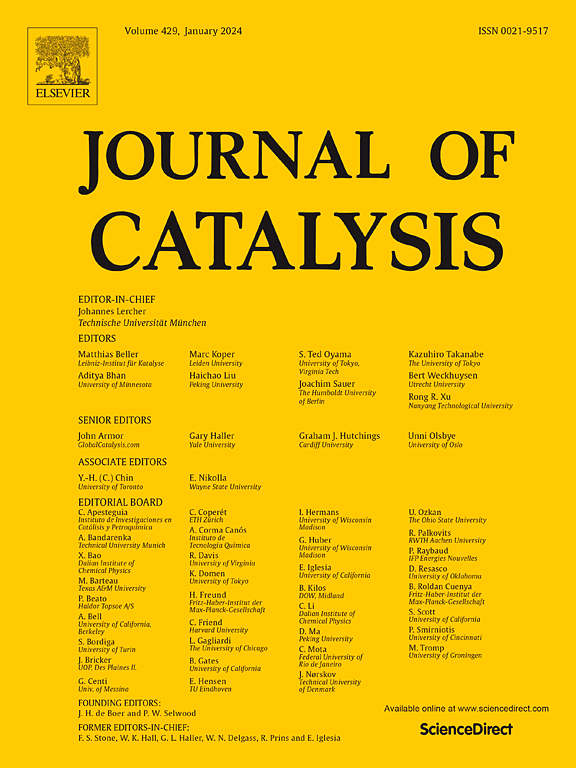Acidity-enhanced Al-MCM-41 synthesized by phase transformation of MWW-type zeolites for the liquid-phase alkylation of lignin-derived phenolic compounds
IF 6.5
1区 化学
Q2 CHEMISTRY, PHYSICAL
引用次数: 0
Abstract
Solid acidic Al-MCM-41 materials are characterized by a high specific surface area and well-ordered hexagonally shaped mesopores. However, their relatively weak acidity compared to microporous zeolites significantly limits their practical applications in industrial catalytic reactions, particularly in upgrading biomass-derived organic feedstock that involves reactions with bulky molecules. Herein, we report a novel synthesis route for preparing acidity-enhanced Al-MCM-41 through the phase transformation of MWW-type zeolite precursors. The phase transformation approach markedly facilitates the incorporation of aluminum species into the MCM-41 framework, leading to strong Brønsted acidity of the resultant Al-MCM-41-T samples, as evidenced by comprehensive characterizations including 29Si and 27Al MAS NMR, NH3-TPD, and Py-IR. Owing to the enhanced acidity and its large pore structures, the as-prepared Al-MCM-41-T-15 sample (with Si/Al = 15) exhibited superior activity and selectivity toward C-alkylated products in both liquid-phase phenol-cyclohexanol and 4-cyclohexylphenol (4-CHP)-cyclohexene alkylation reactions compared the commercial Al-MCM-41-C with a similar Si/Al ratio. These findings afford an effective approach for preparing acidity-enhanced mesoporous solid acids, which hold significant potential for catalyzing lignin-derived bio-oils.


通过 MWW 型沸石相变合成的酸性增强型 Al-MCM-41 用于木质素衍生酚类化合物的液相烷基化反应
固体酸性Al-MCM-41材料具有高比表面积和有序的六边形介孔的特点。然而,与微孔沸石相比,它们相对较弱的酸度极大地限制了它们在工业催化反应中的实际应用,特别是在涉及大分子反应的生物质衍生有机原料的升级方面。本文报道了一种通过mww型沸石前驱体相变制备酸增强Al-MCM-41的新合成路线。通过29Si和27Al MAS NMR、NH3-TPD和Py-IR的综合表征,相变方法显著地促进了铝种进入MCM-41框架,导致所得Al-MCM-41-T样品具有强br / nsted酸性。与Si/Al比值相近的商业Al- mcm -41- c相比,制备的Al- mcm -41- t -15样品(Si/Al = 15)在液相苯酚-环己醇和4-环己基苯酚(4-CHP)-环己烯烷基化反应中对c -烷基化产物表现出更强的活性和选择性。这些发现为制备酸增强介孔固体酸提供了一种有效的方法,它在催化木质素衍生的生物油方面具有重要的潜力。
本文章由计算机程序翻译,如有差异,请以英文原文为准。
求助全文
约1分钟内获得全文
求助全文
来源期刊

Journal of Catalysis
工程技术-工程:化工
CiteScore
12.30
自引率
5.50%
发文量
447
审稿时长
31 days
期刊介绍:
The Journal of Catalysis publishes scholarly articles on both heterogeneous and homogeneous catalysis, covering a wide range of chemical transformations. These include various types of catalysis, such as those mediated by photons, plasmons, and electrons. The focus of the studies is to understand the relationship between catalytic function and the underlying chemical properties of surfaces and metal complexes.
The articles in the journal offer innovative concepts and explore the synthesis and kinetics of inorganic solids and homogeneous complexes. Furthermore, they discuss spectroscopic techniques for characterizing catalysts, investigate the interaction of probes and reacting species with catalysts, and employ theoretical methods.
The research presented in the journal should have direct relevance to the field of catalytic processes, addressing either fundamental aspects or applications of catalysis.
 求助内容:
求助内容: 应助结果提醒方式:
应助结果提醒方式:


